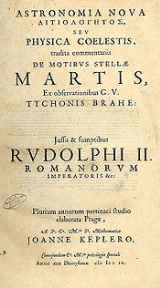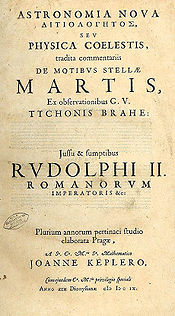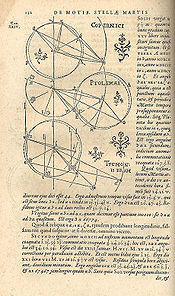
Astronomia nova
Encyclopedia

Johannes Kepler
Johannes Kepler was a German mathematician, astronomer and astrologer. A key figure in the 17th century scientific revolution, he is best known for his eponymous laws of planetary motion, codified by later astronomers, based on his works Astronomia nova, Harmonices Mundi, and Epitome of Copernican...
's ten-year long investigation of the motion of Mars
Mars
Mars is the fourth planet from the Sun in the Solar System. The planet is named after the Roman god of war, Mars. It is often described as the "Red Planet", as the iron oxide prevalent on its surface gives it a reddish appearance...
. One of the greatest books on astronomy
Astronomy
Astronomy is a natural science that deals with the study of celestial objects and phenomena that originate outside the atmosphere of Earth...
, the Astronomia nova provided strong arguments for heliocentrism
Heliocentrism
Heliocentrism, or heliocentricism, is the astronomical model in which the Earth and planets revolve around a stationary Sun at the center of the universe. The word comes from the Greek . Historically, heliocentrism was opposed to geocentrism, which placed the Earth at the center...
and contributed valuable insight into the movement of the planets, including the first mention of their elliptical path and the change of their movement to the movement of free floating bodies as opposed to objects on rotating spheres. It is recognized as one of the most important works of the Scientific Revolution
Scientific revolution
The Scientific Revolution is an era associated primarily with the 16th and 17th centuries during which new ideas and knowledge in physics, astronomy, biology, medicine and chemistry transformed medieval and ancient views of nature and laid the foundations for modern science...
.
Background
Prior to Kepler, Nicolaus CopernicusNicolaus Copernicus
Nicolaus Copernicus was a Renaissance astronomer and the first person to formulate a comprehensive heliocentric cosmology which displaced the Earth from the center of the universe....
proposed in 1543 that the Earth and other planets orbit the Sun. The Copernican model of the solar system was regarded as a device to explain the observed positions of the planets rather than a physical description.
Kepler sought for and proposed physical causes for planetary motion. His work is primarily based on the research of his mentor, Tycho Brahe
Tycho Brahe
Tycho Brahe , born Tyge Ottesen Brahe, was a Danish nobleman known for his accurate and comprehensive astronomical and planetary observations...
. The two, though close in their work, had a tumultuous relationship. Regardless, on his deathbed, Brahe asked Kepler to make sure that he did not “die in vain,” and to continue the development of his Tychonic system
Tychonic system
The Tychonic system was a model of the solar system published by Tycho Brahe in the late 16th century which combined what he saw as the mathematical benefits of the Copernican system with the philosophical and "physical" benefits of the Ptolemaic system...
. Kepler would instead write the Astronomia nova, in which he rejects the Tychonic system, as well as the Ptolemaic system and the Copernican system. Some scholars have speculated that Kepler’s dislike for Brahe may have had a hand in his rejection of the Tychonic system and formation of a new one.
Structure and Summary of the Astronomia nova

The Astronomia novas introduction, specifically the discussion of scripture, was the most widely distributed of Kepler’s works in the seventeenth century. The intro outlines the four steps Kepler took during his research. The first is his claim that the sun itself and not any imaginary point near the sun (as in the Copernican system) is the point where all the planes of the eccentrics of the planets intersect, or the center of the orbits of the planets. The second step consists of Kepler placing the sun as the center and mover of the other planets. This step also contains Kepler’s reply to objections against placing the sun at the center of the universe, including objections based on scripture. In reply to scripture, he argues that it is not meant to claim physical dogma, and the content should be taken spiritually. In the third step, he posits that the sun is the source of the motion of all planets, using Brahe’s proof based on comets that planets do not rotate on orbs. The fourth step consists of describing the path of planets as not a circle, but an oval.
As the Astronomia nova proper starts, Kepler demonstrates that the Tychonic, Ptolemaic, and Copernican systems are indistinguishable on the basis of observations alone. The three models predict the same positions for the planets in the near term, although they diverge from historical observations, and fail in their ability to predict future planetary positions by a small, though absolutely measurable amount. Kepler here introduces his famous diagram of the movement of Mars in relation to Earth if Earth remained unmoving at the center of its orbit. The diagram shows that Mars’s orbit would be completely imperfect and never follow along the same path.
Kepler discusses all his work at great length throughout the book. He addresses this length in the sixteenth chapter:
If thou art bored with this wearisome method of calculation, take pity on me, who had to go through with at least seventy repetitions of it, at a very great loss of time.
Kepler, in a very important step, also questions the assumption that the planets move around the center of their orbit at a uniform rate. He finds that computing critical measurements based upon the Sun's actual position in the sky, instead of the Sun's "mean" position injects a significant degree of uncertainty into the models, opening the path for further investigations. The idea that the planets do not move in a uniform rate, but with a speed proportional to their distance, was completely revolutionary, and would become his second law (discovered before his first). Kepler, in his calculations leading to his second law, made multiple math errors, which luckily cancelled each other out “as if by miracle.”
Given this second law, he puts forth in Chapter 33 that the sun is the engine that moves the planets. To describe the motion of the planets, he claims the sun emits a physical species, analogous to the light it also emits, which pushes the planets along. He also suggests a second force within every planet itself that pulls it toward then sun to keep it from spiraling off into space.
Kepler then attempts to finally find the true path of the planets, which he determines is an ellipse
Ellipse
In geometry, an ellipse is a plane curve that results from the intersection of a cone by a plane in a way that produces a closed curve. Circles are special cases of ellipses, obtained when the cutting plane is orthogonal to the cone's axis...
. His initial attempt to define the orbit of Mars, far before he arrived at the ellipse shape, was off by only eight minutes, yet this was enough for Kepler to require an entirely new system. Kepler tried a number of shapes before the ellipse, including an egg shape. What’s more, he discovered the mathematical definition for the ellipse as the orbit, then rejected it, then adopted the ellipse without knowing that it was the same:
”I laid [the original equation] aside, and fell back on ellipses, believing that this was quite a different hypothesis, whereas the two, as I shall prove In the next chapter, are one in the same…Ah, what a foolish bird I have been!”
Kepler's Knowledge of Gravity
In his introductory discussion of a moving earth, Kepler addressed the question of how the Earth could hold its parts together if it moved away from the center of the universe which, according to Aristotelian physicsAristotelian physics
Aristotelian Physics the natural sciences, are described in the works of the Greek philosopher Aristotle . In the Physics, Aristotle established general principles of change that govern all natural bodies; both living and inanimate, celestial and terrestrial—including all motion, change in respect...
, was the place toward which all heavy bodies naturally moved. Kepler proposed an attractive force similar to magnetism, which may have been known by Newton.
"Gravity is a mutual corporeal disposition among kindred bodies to unite or join together; thus the earth attracts a stone much more than the stone seeks the earth. (The magnetic faculty is another example of this sort).... If two stones were set near one another in some place in the world outside the sphere of influence of a third kindred body, these stones, like two magnetic bodies, would come together in an intermediate place, each approaching the other by a space proportional to the bulk [moles] of the other.... For it follows that if the moon's power of attraction will be much more likely to extend to the moon and far beyone, and accordingly, that nothing that consists to any extent whatever of terrestrial material, carried up on high, ever escapes the grasp of this mighty power of attraction.”
Kepler considered that this attraction was mutual and was proportional to the bulk of the bodies, but he considered it to have a limited range and he did not consider whether or how this force may have varied with distance. Furthermore, this attraction only acted between "kindred bodies"—bodies of a similar nature, a nature which he did not clearly define. Kepler's idea differed significantly from Newton's later concept of gravitation and it can be "better thought of as an episode in the struggle for heliocentrism
Heliocentrism
Heliocentrism, or heliocentricism, is the astronomical model in which the Earth and planets revolve around a stationary Sun at the center of the universe. The word comes from the Greek . Historically, heliocentrism was opposed to geocentrism, which placed the Earth at the center...
than as a step toward Universal gravitation.
Kepler's laws
The Astronomia nova records the discovery of the first two of the three principles known today as Kepler's laws of planetary motionKepler's laws of planetary motion
In astronomy, Kepler's laws give a description of the motion of planets around the Sun.Kepler's laws are:#The orbit of every planet is an ellipse with the Sun at one of the two foci....
, which are:
- That the planets move in ellipticalEllipseIn geometry, an ellipse is a plane curve that results from the intersection of a cone by a plane in a way that produces a closed curve. Circles are special cases of ellipses, obtained when the cutting plane is orthogonal to the cone's axis...
orbits with the sun at one focusFocus (geometry)In geometry, the foci are a pair of special points with reference to which any of a variety of curves is constructed. For example, foci can be used in defining conic sections, the four types of which are the circle, ellipse, parabola, and hyperbola...
. - That the speed of the planet changes at each moment such that the time between two positions is always proportional to the area swept out on the orbit between these positions.
Kepler discovered the "second law" before the first. He notices, as recorded in Chapter 32 of the Astronomia nova that the speed of the planet varies inversely based upon its distance from the Sun, and therefore he could measure changes in position of the planet by adding up all the distance measures, or looking at the area along an orbital arc.
However, Kepler's "area-time principle" did not facilitate easy calculation of planetary positions. Kepler could divide up the orbit into an arbitrary number of parts, compute the planet's position for each one of these, and then refer all questions to a table, but he could not determine the position of the planet at each and every individual moment because the speed of the planet was always changing. This paradox, referred to as the "Kepler problem
Kepler problem
In classical mechanics, the Kepler problem is a special case of the two-body problem, in which the two bodies interact by a central force F that varies in strength as the inverse square of the distance r between them. The force may be either attractive or repulsive...
," prompted the development of calculus
Calculus
Calculus is a branch of mathematics focused on limits, functions, derivatives, integrals, and infinite series. This subject constitutes a major part of modern mathematics education. It has two major branches, differential calculus and integral calculus, which are related by the fundamental theorem...
.
The "third law"
Kepler discovered his "third law" a decade after the publication of the Astronomia nova as a result of his investigations in the 1619 Harmonices Mundi (Harmonies of the world). He found that the ratio of the length of the semi-major axis of each planet's orbit (cubed), to the time of its orbital period (squared), is the same for all planets.Commemoration
The 2009 International Year of AstronomyInternational Year of Astronomy
The International Year of Astronomy was a year-long celebration of astronomy that took place in 2009 to coincide with the 400th anniversary of the first recorded astronomical observations with a telescope by Galileo Galilei and the publication of Johannes Kepler's Astronomia nova in the 17th century...
commemorates the 400th anniversary of the publication of this work.

